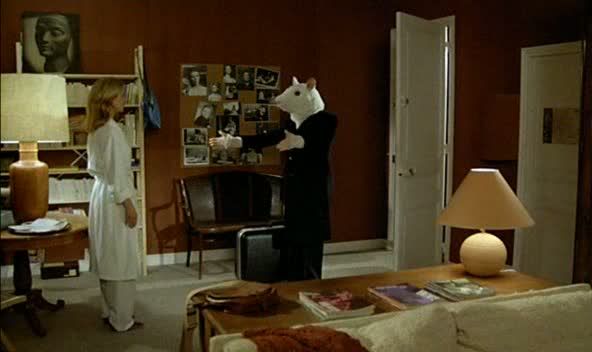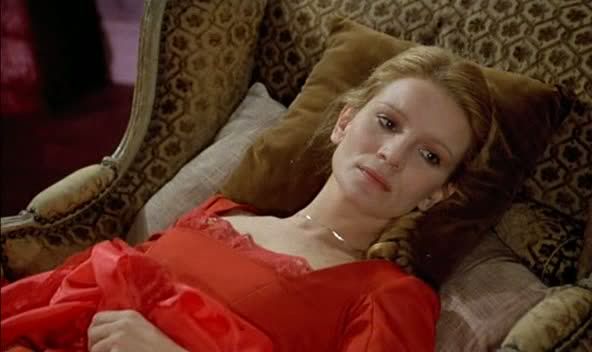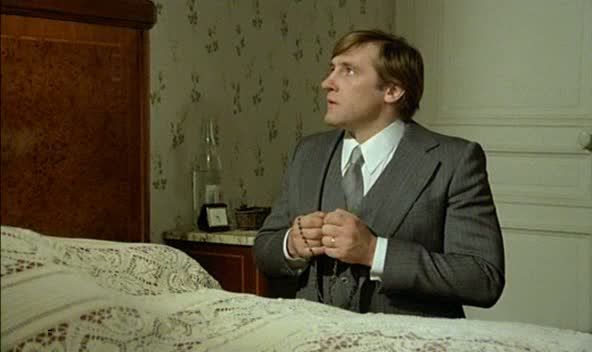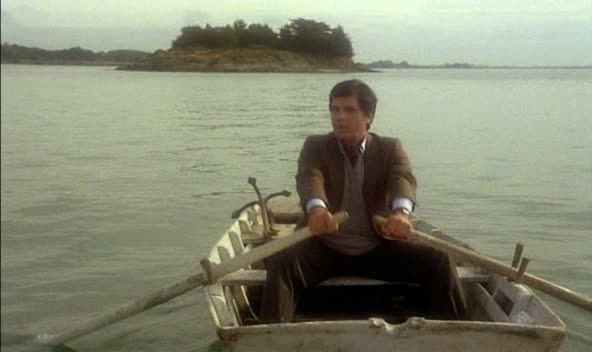

Alain Resnais' Mon oncle d'Amerique is a fascinating narrative experiment from the director who, more than any other, has always been concerned with the workings of the human mind. This film takes as its subject the biological processes by which the mind and personality are shaped, the ways in which one's persona is formed from the sum of one's experiences and the neurological foundations governing our reactions in various situations. The film is narrated, sporadically, by the French neurosurgeon Henri Laborit, who discusses the film's three interconnected stories in terms of behavioral biology ideas that explain the actions of the characters in these dramas. Laborit discusses fight-or-flight in a human society in which the "fight" component of that response has been rendered largely unacceptable. He analyzes careers and relationships in terms of systems of reward and punishment that are ingrained from very early in childhood. He observes the ways in which psychological stresses related to these biological underpinnings are expressed in anxiety and psychosomatic illness.
It's a potentially reductive and limiting rubric, pulling apart these dramatic stories and discussing the action in terms of biology and behavior. In fact, though, Resnais, working from a script by Jean Gruault, is after something far more complex. Gruault had also written the script for François Truffaut's The Wild Child, and at one point Laborit's voiceover mentions that when a human child grows up in isolation, without any human contact, he will be like "a little animal" with no language or other human behaviors. Resnais, much more powerfully and inventively than Truffaut, is exploring what it means to be human, exploring the essence of humanity as a sum of experiences, biology, and most crucially, one's interactions with other people. A core idea of the film is the concept that the individual human mind is actually formed from contacts with other people, from ideas learned from others, experiences, memories. An individual human, then, is actually comprised of the other people he or she has come into contact with, the experiences they've shared, the memories they've formed together. Resnais and Gruault, in collaboration with Laborit, have rendered science and biology as poetry, discovering that to analyze and dissect the nature of human behavior is not to render it cold and clinical, but to make the mystery all the more remarkable.
As Laborit says towards the end of the film, implicitly responding to such criticisms of science, "knowing the laws of gravity doesn't make us free from gravity." In the same way, the film's analysis of its stories in terms of behaviorist theories doesn't render the stories abstract or rob them of their power as human dramas. Indeed, what's quite remarkable about the film is that despite its constant breaking of the narrative illusion with explanatory voiceovers and comparisons to animals and laboratory experiments, the film remains consistently affecting on a human level. These are simple stories of disappointment, anxiety, and desire. René (Gérard Depardieu) is plagued by anxiety about his career; he's dedicated himself to his work but a series of mergers and shake-ups at his company put him in ever more precarious situations, ultimately forcing him to choose between his career and his family life. Jean (Roger Pierre) is a politician and aspiring writer who starts an affair with Janine (Nicole Garcia) just as his own career starts going through some trouble. And Janine has her own story, about her dreams of being an actress and her up-and-down romance with the married Jean.


It's not only biology that drives these stories. People learn from experiences, from the models provided by parents and other relatives — and also the models provided by the cinema. Throughout the film, Resnais cuts in excerpts of black-and-white films starring Jean Gabin, Jean Marais, and Danielle Darrieux, who provide templates for the actions of the three protagonists, cinematic role models whose behaviors are often echoed in this film's stories. The cinematic reference points parallel the biological ones, suggesting that just as biology contributes to the shape of a person's life and soul, the things that a person sees and experiences also add to the person they might become.
In the film's second half, Resnais shuffles the structure and begins interspersing the dramatic scenes more and more frequently with scenes of laboratory experiments featuring mice, scenes from the protagonists' childhoods that connect back to their later lives, and, hilariously, inserts in which men in rat masks enact scenes of love and competition. Those surreal interludes simultaneously buttress the theme of biology and behavior and undercut it, since they emphasize the gap between the biological foundations of behavior and the actual complexity and variety of human behavior. This is why, far from reducing humanity to a series of programmed responses, what Resnais, Gruault and Laborit are doing here is really all about the complexity and mystery of behavior, the intimacy between science and poetry in creating a full portrait of humanity.
In the film's powerful, mysterious final sequence, Resnais shows an urban building that has an image of a shady green forest covering one of its walls. Resnais cuts to successively closer and closer shots, and in each one the illusion of a tree growing from concrete is shattered more and more decisively. First the texture of bricks can be seen in the image, which is a mural painted on the wall. As Resnais cuts to even closer views, the overall sense of the image is compromised, and it stops looking like a tree at all — in the closest shot, the film's final shot, the image has become abstract smears of paint on bricks. At that intimate distance, it is impossible to tell that from afar the paint creates a rather convincing illusion of forest greenery; up close it's just paint, seemingly splattered on the bricks with little care, just a splotch that looks like nothing at all. It's a startling and ambiguous metaphor, suggesting that the closer we look at something — like human behavior — the more mysteries are introduced, even as looking closely increases understanding about how things are put together.

2 comments:
I love this film :)
One of Resnain's Absolute Masterpieces, Mon Oncle d'Amerique is not onlky about the three indivioduals depicted. It's about the French National Character. This was brought home to me when I first saw the fiolm with Christine Legrand (Michael's first wife) who went on for a half an hour about the way Garcia, Pierre and Depardieu stand for aspects of the 'typical frenchman" and the subtle ways in which Resnis -- though Laborit -- explores this. At the last it's a film of enormous melancholy. No one gets what they want.
Post a Comment